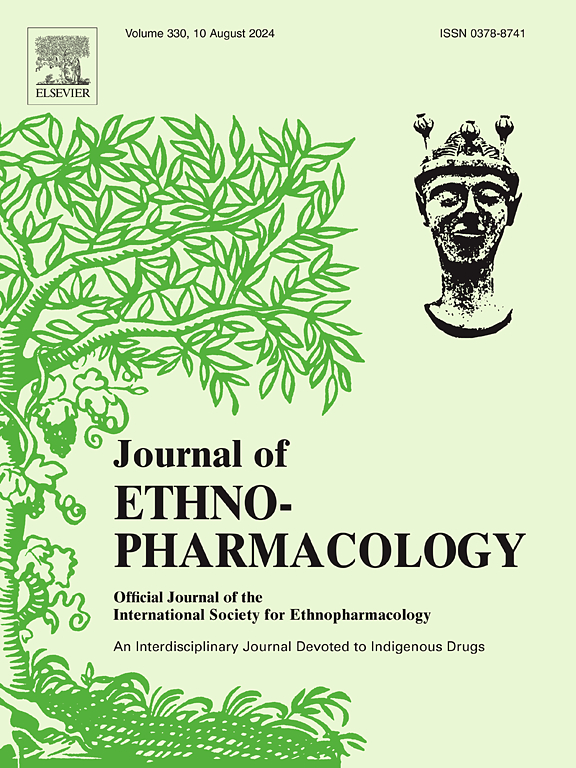Investigating therapeutic effects and the underlying mechanisms of jia-wei-yin-chen-hao-tang in non-alcoholic fatty liver disease based on network pharmacology analysis and experimental validation
IF 5.4
2区 医学
Q1 CHEMISTRY, MEDICINAL
引用次数: 0
Abstract
Ethnopharmacological relevance
Yin–Chen–Hao–Tang (YCHT) was initially recorded in the Chinese medicine classic Shang Han Lun, which was written by Zhang Zhongjing, and it has long been used orally as a classic formula. Jia–Wei–Yin–Chen–Hao–Tang (JWYCHT) comprises YCHT added with the widely used Chinese Yi medicine Liangtoumao (Incarvillea arguta (Royle) Royle). JWYCHT has become a promising therapeutic option for several liver and gallbladder disorders, including nonalcoholic fatty liver disease (NAFLD), among the Chinese Yi population. However, its specific mechanism of action remains poorly understood.
Aim of the study
This study aimed to explore the therapeutic effects and underlying mechanism of action of JWYCHT through network pharmacological analysis and experimental validation.
Methods
NAFLD-related transcriptome data and target genes associated with JWYCHT were retrieved from public databases. Initially, candidate genes were obtained by overlapping differentially expressed genes (DEGs) from NAFLD and control samples in GSE63067 with the drug target genes. Subsequently, candidate biomarkers were further obtained using the algorithm in cytoHubba plug-in. Biomarkers were further identified via receiver operating characteristic (ROC) analysis and expression validation, and enrichment analysis was executed to explore the potential mechanisms of NAFLD biomarkers. HPLC and UPLC/QE-HFX were used to determine the chemical components of JWYCHT. Finally, the findings were validated through molecular biology experiments involving a mouse model of NAFLD induced by high-fat diet.
Results
A total of 416 DEGs were acquired, with 51 candidate genes subjected to enrichment analysis. Seven candidate biomarkers, including C-X-C motif chemokine ligand 10 (CXCL10) and caspase-1 (CASP1), were identified from an algorithm in cytoHubba plug-in. ROC analysis confirmed CASP1 and CXCL10 as viable biomarkers, with the latter (odds ratio = 1.305, p < 0.05) emerging as a risk factor for NAFLD. 41 compounds were identified by UPLC/QE-HFX in JWYCHT. The HPLC results demonstrated distinct variations in chemical profiles between JWYCHT, YCHT, and their component medicinal herbs. A series of molecular experiments revealed that JWYCHT effectively treated NAFLD in the mouse model. It can reduce the expressions of CXCL10 and CASP1, improve liver function biochemical indicators and histopathological changes, and alleviate inflammation and lipid deposition.
Conclusion
Bioinformatics and experimental validation revealed that JWYCHT can alleviate hepatic inflammation and lipid deposition in NAFLD by reducing the expressions of CXCL10 and CASP1. Our research results offer an experimental foundation for the therapeutic efficacy and mechanism of JWYCHT and guidance for its clinical application.

基于网络药理学分析和实验验证,探讨加味银陈好汤治疗非酒精性脂肪肝的疗效及机制
银陈浩汤最早记载于张仲景所著的中医经典《尚汉论》中,长期以来作为经典口服药。嘉味银陈好汤(JWYCHT)由YCHT和广受欢迎的中药凉头茅(Incarvillea arguta (Royle) Royle)组成。JWYCHT已成为中国彝族人群中几种肝脏和胆囊疾病(包括非酒精性脂肪性肝病(NAFLD))的有希望的治疗选择。然而,其具体的作用机制仍然知之甚少。本研究旨在通过网络药理分析和实验验证,探讨JWYCHT的治疗效果及其作用机制。方法从公共数据库中检索snafld相关转录组数据和JWYCHT相关靶基因。最初,通过将来自NAFLD和对照样本的差异表达基因(DEGs)与GSE63067中的药物靶基因重叠获得候选基因。随后,在cytoHubba插件中使用该算法进一步获得候选生物标志物。通过受试者工作特征(ROC)分析和表达验证进一步鉴定生物标志物,并进行富集分析以探索NAFLD生物标志物的潜在机制。采用高效液相色谱(HPLC)和UPLC/QE-HFX对其化学成分进行测定。最后,通过高脂肪饮食诱导的NAFLD小鼠模型的分子生物学实验验证了这些发现。结果共获得416个deg,其中51个候选基因进行富集分析。通过cytoHubba插件的算法鉴定出7个候选生物标志物,包括C-X-C基序趋化因子配体10 (CXCL10)和caspase-1 (CASP1)。ROC分析证实CASP1和CXCL10是可行的生物标志物,后者(优势比= 1.305,p <;0.05)成为NAFLD的危险因素。通过UPLC/QE-HFX在JWYCHT中鉴定出41个化合物。高效液相色谱结果显示,JWYCHT、YCHT及其成分药材的化学谱存在明显差异。一系列分子实验表明,JWYCHT对小鼠模型NAFLD有有效的治疗作用。可降低CXCL10和CASP1的表达,改善肝功能生化指标和组织病理学改变,减轻炎症和脂质沉积。结论生物信息学和实验验证表明,JWYCHT可通过降低CXCL10和CASP1的表达,减轻NAFLD的肝脏炎症和脂质沉积。我们的研究结果为JWYCHT的疗效和作用机制提供了实验基础,并为其临床应用提供了指导。
本文章由计算机程序翻译,如有差异,请以英文原文为准。
求助全文
约1分钟内获得全文
求助全文
来源期刊

Journal of ethnopharmacology
医学-全科医学与补充医学
CiteScore
10.30
自引率
5.60%
发文量
967
审稿时长
77 days
期刊介绍:
The Journal of Ethnopharmacology is dedicated to the exchange of information and understandings about people''s use of plants, fungi, animals, microorganisms and minerals and their biological and pharmacological effects based on the principles established through international conventions. Early people confronted with illness and disease, discovered a wealth of useful therapeutic agents in the plant and animal kingdoms. The empirical knowledge of these medicinal substances and their toxic potential was passed on by oral tradition and sometimes recorded in herbals and other texts on materia medica. Many valuable drugs of today (e.g., atropine, ephedrine, tubocurarine, digoxin, reserpine) came into use through the study of indigenous remedies. Chemists continue to use plant-derived drugs (e.g., morphine, taxol, physostigmine, quinidine, emetine) as prototypes in their attempts to develop more effective and less toxic medicinals.
 求助内容:
求助内容: 应助结果提醒方式:
应助结果提醒方式:


